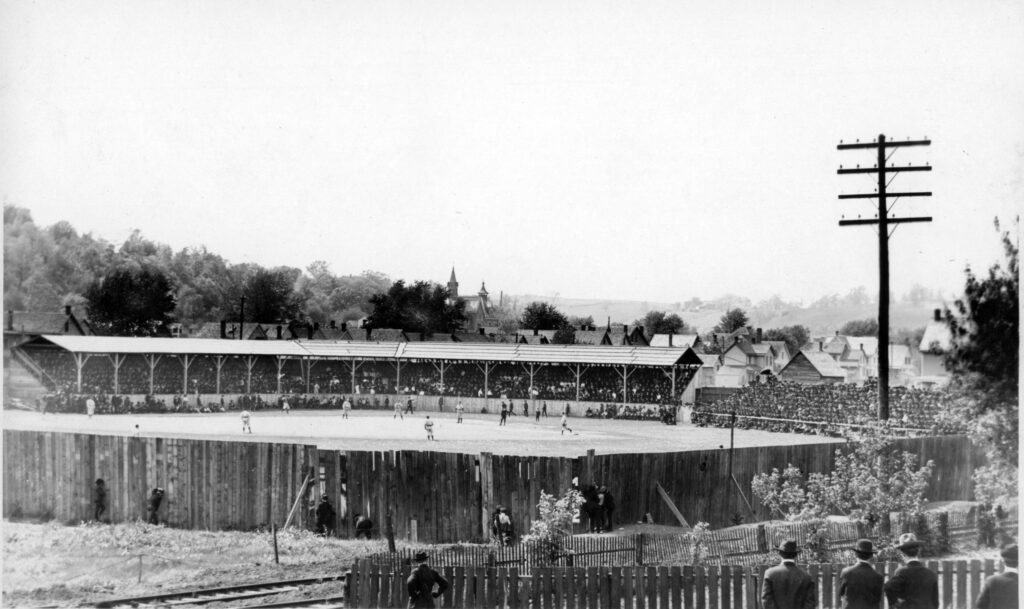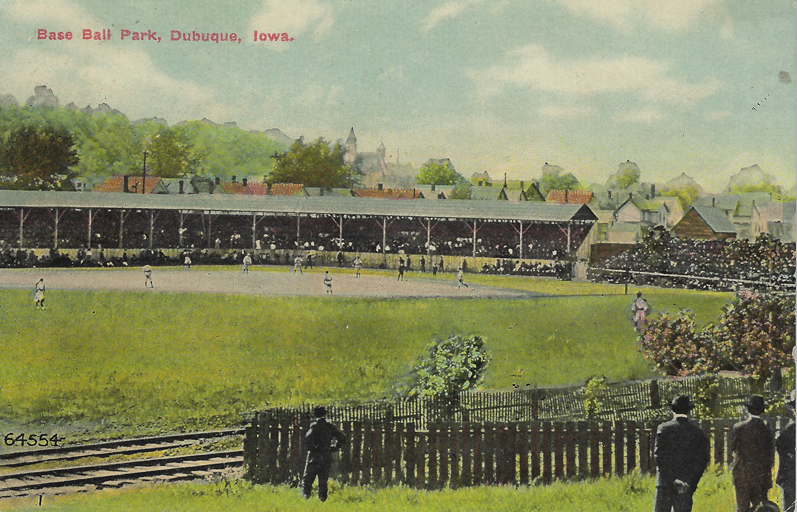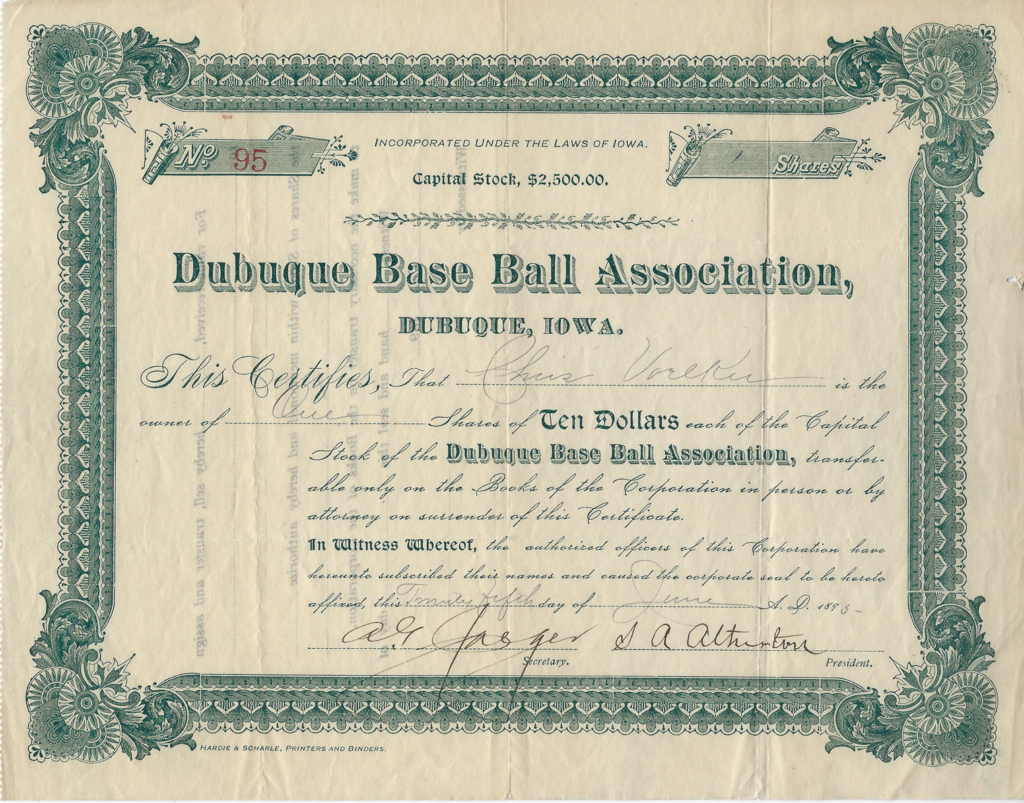For the past 50 years a popular postcard image believed to have been taken between 1910 and 1912 has long been misidentified as Dubuque’s Base Ball Park – today’s Comiskey Park. The misidentified image appears in numerous books and websites. For over a decade, I have felt a quiet uneasiness that had me suspect the image may not be of the old professional baseball field built by Ted Sullivan at the corner of East 24th and Jackson Streets in 1879.
The image was taken from an elevated location outside of the ballpark’s centerfield fence, on the other side of railroad (or streetcar) tracks. The original photograph captures the outfield fence with young children peering through the pushed-out knotholes in the plywood fencing. The kids were referred to as the “knothole gang”.

The grandstand and covered amphitheater are full of fans with players on the field at their positions. Off in the distance you can see the steeples of a church that was believed to be Sacred Heart Church at the corner of East 22nd Street and Windsor Avenue.
The image was used for a popular 1912 postcard sold around the Dubuque area. The postcard is a painted version of the original photograph with some modifications to the original print. The postcard is missing some landmarks that are in the original image but removed during painting. The most noticeable removal is the outfield fence and the knothole gang. Another removed landmark, and less noticeable, is the hill that towers above the church and to the right. This hill crest in the image turned out being critical in determining the true location and name of the church and the ballfield.
Over the years I have tried to take a copy of the original photograph owned by Jeff Mozena and align it with the landmarks and houses around the area of 24th Street and Jackson Street. Newspaper articles from 1879 indicate that home plate was located at the corner of 24th & Jackson. Based on that information, the assumption was the railroad tracks were the tracks that ran along today’s Heritage Trail along Elm Street. But that assumption presented a problem. This assumption would place the church in the image in the 2300 block of Central Avenue, where no church exists.
If the church in the images was Sacred Heart, the tracks would have to have been from the Jackson Street streetcar line and Homeplate of the ballpark would have to have been at the corner of 24th and Washington Streets, and not 24th and Jackson Sts. This did not add up.
This led me to focus in on the image of the church. The first thing I noticed about the church was it did not mirror the steeple configuration of Sacred Heart. This led me to consider whether the baseball park was actually on the other side of today’s Comiskey Park, with home plate being at the corner of East 25th Street and Jackson Street. Upon further investigation, I determined that home plate of the 1879 Base Ball Park was indeed at the corner of 24th & Jackson based on newspaper articles over the years. I also determined during this investigation, that the church was Dubuque’s Holy Ghost Church at 2900 Central Avenue, and not Sacred Heart. If you were looking at Sacred Heart from Comiskey Park, you would not see a long hill crest to the right of the church like you do in the original image.
At this point in my investigation, I turned to my prior research on Dubuque baseball. I was familiar with the fact that Dubuque had numerous baseball fields used throughout our history, with the last being 4th Street Park, also known as Petrakis Park. I knew organized baseball started out on a ballfield at the Dubuque Driving Park in the 1860s. The Driving Park was located at the corner of E.32nd Street (Peru Road) and Central Avenue, with the ballfield located where the local UAW union hall and Prairie Farms Dairy are located. In 1879, Ted Sullivan built Dubuque’s Base Ball Park at E.24th St. & Jackson St. In 1895, Dubuque’s professional baseball field moved from 24th & Jackson to E.27th and Washington Streets and was refereed to as League Park. In the later half of the twentieth century, Base Ball Park (24th & Jackson) and League Park (27th & Washington) have been confused with one another. In 1914, the City of Dubuque opened the first municipal park in the nation owned by a city for professional baseball play. The 4th Street Park (aka Petrakis Park) would be Dubuque’s primary professional baseball field from 1914-1976.
Putting all the pieces together, it becomes clear the postcard image is of the 27th Street League Park, which was Dubuque’s professional ballfield from 1895-1913. The park was built by Tom Loftus using a stock subscription in 1895 forming the Dubuque Base Ball Association. The first game on the ballfield was played between Tom Loftus’s Dubuque Dubs and Charley Comiskey’s St. Paul Saints of the Western League.
[FROM THE ARCHIVES is a periodical focusing on interesting stories behind artifacts in the Library of John T. Pregler. Click on the images to access the online record of the pictured artifact.]
Copyright – 2020 – The Lens of History – John T. Pregler. This story or its images cannot be published, broadcast, rewritten or redistributed without prior authorization from the author or The Lens of History.


